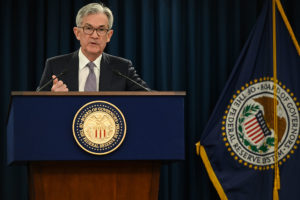
Fed to buy $600B worth of loans in new ‘Main Street’ COVID-19 program
By onAnnouncements | Business Practices | Legal | Market Trends
The Federal Reserve on Thursday announced it would promote small-business loans by spending $600 billion to buy 95 percent of low-interest loans made under a new “Main Street Lending Program.”
Companies with up to 10,000 employees or up to $2.5 billion in 2019 revenues are eligible for the program, which was part of the $2.3 trillion aid plan the Fed announced Thursday.
“Our country’s highest priority must be to address this public health crisis, providing care for the ill and limiting the further spread of the virus,” Federal Reserve Chairman Jerome Powell said in a statement. “The Fed’s role is to provide as much relief and stability as we can during this period of constrained economic activity, and our actions today will help ensure that the eventual recovery is as vigorous as possible.”
Main Street borrowers must take out a loan for at least $1 million.
“Eligible banks may originate new Main Street loans or use Main Street loans to increase the size of existing loans to businesses,” the Fed explained in a news release Thursday. “Banks will retain a 5 percent share, selling the remaining 95 percent to the Main Street facility, which will purchase up to $600 billion of loans.”
Loans granted to a bank’s existing borrower will max out at “the lesser of (i) $150 million, (ii) 30% of the Eligible Borrower’s existing outstanding and committed but undrawn bank debt, or (iii) an amount that, when added to the Eligible Borrower’s existing outstanding and committed but undrawn debt, does not exceed six times the Eligible Borrower’s 2019 earnings before interest, taxes, depreciation, and amortization.”
Loans to a new borrower will be capped at “the lesser of (i) $25 million or (ii) an amount that, when added to the Eligible Borrower’s existing outstanding and committed but undrawn debt, does not exceed four times the Eligible Borrower’s 2019 earnings before interest, taxes, depreciation, and amortization.”
Borrowers must have been “in good financial standing before the crisis.”
The eligible banks can’t reduce or terminate your line of credit for using the new Main Street loans. Conversely, you’re prohibited as a borrower from reducing or cancelling your line of credit out from under the lender.
The loans will mature in four years, with payments able to be deferred for one of the years. Interest is adjustable, calculated at the Secured Overnight Financing Rate plus 2.5-4 percentage points. (250-400 basis points) According to the New York Fed, the SOFR stood at 0.1 percent on Wednesday. There’s no penalty for prepayment.
You can’t use the loans to refinance existing debt. However, you can apply for the loans even if you’ve received or applied for a Paycheck Protection Program loan, according to the Fed.
“Firms seeking Main Street loans must commit to make reasonable efforts to maintain payroll and retain workers,” the Fed wrote in a news release Thursday. However, there’s not an incentive like the Paycheck Protection Program, which forgives the whole loan if small businesses preserve staff and wages.
The Main Street terms aren’t completely set in stone, and the Fed is seeking public comment from Americans until April 16.
“The Federal Reserve and the Treasury recognize that businesses vary widely in their financing needs, particularly at this time, and, as the program is being finalized, will continue to seek input from lenders, borrowers, and other stakeholders to make sure the program supports the economy as effectively and efficiently as possible while also safeguarding taxpayer funds.”
Correction: An earlier version of this story incorrectly described the forgivable amount of PPP loans.
Businesses can borrow about 2.5 months worth of payroll, up to $10 million. The SBA forgives the whole thing and interest if the money was spent during an eight-week period; it decreases the forgivable amount proportional to cuts in the company’s workforce or pay. At least 75 percent of the borrowed amount must go to payroll during those eight weeks, the remaining 25 percent can be used for certain eligible expenses including utilities and rent.
“The amount of loan forgiveness can be up to the full principal amount of the loan and any accrued interest,” the SBA wrote April 15. “That is, the borrower will not be responsible for any loan payment if the borrower uses all of the loan proceeds for forgiveable purposes described below and employee and compensation levels are maintained. The actual amount of loan forgiveness will depend, in part, on the total amount of payroll costs, payments of interest on mortgage obligations incurred before February 15, 2020, rent payments on leases dated before February 15, 2020, and utility payments under service agreements dated before February 15, 2020, over the eight-week period following the date of the loan. However, not more than 25 percent of the loan forgiveness amount may be attributable to non-payroll costs.”
The article has since been corrected to address this.
More information:
Federal Reserve, April 9, 2020
Submit public comment on Fed Main Street loan plan (deadline is April 16).
Main Street New Loan Facility term sheet
Federal Reserve, April 9, 2020
Main Street Expanded Loan Facility term sheet
Federal Reserve, April 9, 2020
Featured image: Federal Reserve Chairman Jerome Powell is shown. (Provided by Federal Reserve)
